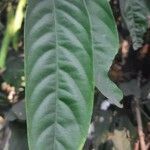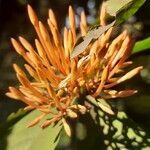Tree up to 10 m tall and 10 cm in diam., sometimes shrub or medium-sized shrub, 4.5 m tall. Leaves (l-)4-6-jugate, subsessile to shortly petioled; (petiole and) rachis (0.5-)7-15(-30) cm long. Leaflets chartaceous or subcoriaceous, elliptic-oblong or elliptic-lanceolate, or lanceolate, (3.5-)7-18(-26) by (1 — )3 — 5( — 9) cm, the lowest pair usually smaller; glabrous; apex acuminate; base cuneate, obtuse, or rounded, symmetric, rarely the lowest pair obscurely subcordate; midrib slightly elevated above, prominent beneath; nerves 5-9(-12) per side; subsessile to petiolules 2-5 mm. Inflorescences 1.5-12(-20) cm wide, glabrous, main branches up to c. 6 cm long, 1.5-2 mm diam.; bracts broadly ovate, ovate or obovate, 1-6 by 1 — 3.5( — 5) mm, caducous or persistent, puberulous and/or minutely ciliate on the margin; bracteoles persistent during anthesis, erect, embracing the pedicel, never spreading more than 45° from the pedicel, ovate, elliptic, or obovate, 2-7 by 1.5-4 mm, sparsely puberulous, subglabrous or glabrous except minutely ciliate on the margin; pedicels 8-18 mm, the length between bracteoles and flower (4-)7-10 mm. Flowers obscurely or not articulated near the base, subglabrous or glabrous, orange yellow, when older deep orange or orange red, fragrant during the night. Hypanthium 9-20 mm long, 1-3 mm wide at the throat. Calyx lobes elliptic or obovate, 7-13 by 5-9 mm. Stamens (5 — )6 — 8( — 10); filaments (10-) 17-25 mm, glabrous; anthers ellipsoid or oblong, 1.5-2 mm long; staminodes 0-2. Pistil stipitate, free part of stipe 2-4 mm, hairy; ovary 4-6 mm long, puberulous, 8-10(-12)-ovuled; style 15-20 mm, glabrous; stigma capitellate. Pods oblong or elongate-oblong (sometimes slightly curved), or scimitar-shaped, 12.5-25 by 3.5-6.5 cm, c. 1 cm thick, leathery or woody, (l-)4-6-(or more-)seeded, with straight or curved, up to c. 1 cm long beaked apex, and cuneate or obliquely rounded base, valves coiling. Seeds oblong-ellipsoid, sometimes slightly reniform, 2-3 by 1.25-2 cm, and 0.6-1 cm thick.
More
A small evergreen tree. It grows 6-9 m high. The bark is dark brown. The leaves are compound and 30 cm long. There are 4 pairs of leaflets. These are oval and pointed. They can be 25 cm long by 6 cm wide. New leaves are pink. The flowers have a scent. The flowers are orange-yellow. They are in flat topped arrangement 7.5-10 cm across. The individual flowers are 2.5 cm long. The fruit are leathery pods. These are red but turn grey at maturity. They are 5-15 cm long by 2.5 cm wide. They are pointed at the tip. There are 4-8 grey seeds. The pods split into 2 halves and curl up on ripening.



